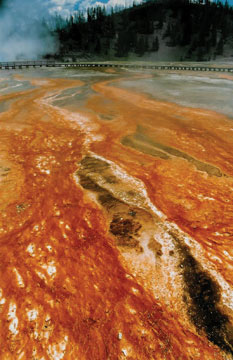|
NEWS NOTES
Franken-proteins tell heat tale
| Hot water that drains into the Madison River from the Grand Prismatic Spring in the Lower Geyser Basin of Wyoming's Yellowstone National Park has deposited a mound of brightly colored red and yellow minerals. |
Bacteria that lived billions of years ago can’t be brought back to life, but scientists have devised a way to “resurrect” parts of them. And those temperature-sensitive proteins, once encoded by the genes of the ancient bacteria, contain a primordial thermometer that provides new clues about Earth’s early environment.
All modern bacteria contain a protein called “elongation factor,” although each species encodes for a slightly different form of the protein, says Eric Gaucher, a biologist at the Foundation for Applied Molecular Evolution in Gainesville, Fla. Depending on its form, that elongation factor responds differently to changes in temperature: Bacteria that prefer warm environments contain a form that is highly heat-tolerant, maintaining its structure rather than unfolding at high temperatures, while bacteria that thrive in colder environments contain a form that unfolds at hotter temperatures.
Because all known species of bacteria contain this protein, Gaucher and his colleagues reasoned that it was probably present in ancient bacteria as well, and which forms were present at different times could potentially offer clues to temperatures on ancient Earth. That, in turn, would tell researchers more about the environment in which the earliest forms of life thrived. However, with no actual ancient proteins to study, how these proteins would respond to temperature is seemingly impossible to guess.
There is a way to try to recreate these ancient proteins, however. Through computational reconstruction, scientists can statistically estimate ancient bacterial DNA sequences based on models of molecular evolution. By synthesizing these sequences and cloning them into modern bacteria such as E. coli, scientists can observe how the proteins respond to different temperatures.
Gaucher used this technique previously, resurrecting proteins from 3.8 million-year-old bacteria that suggested Earth was hotter at that time. But that was only one point in time, he says. To further flesh out the method, he wanted to try to create a timescale of ancient temperatures that would correspond to different times in Earth’s history, specifically times that would correspond to geological estimates of paleotemperatures based on oxygen-18 data. The researchers used 20 of these ancient elongation factors that ranged in age from 800 million to 3.8 billion years old, as estimated by the bacterial “molecular clock,” which tracks genetic changes in the bacterial evolutionary tree.
What they found was that the form of the elongation factor in the bacteria changed through time from a heat-tolerant type to one that only functions at lower temperatures, which suggests a cooling trend from 75 degrees Celsius at 3.8 billion years ago to about 40 degrees Celsius at 800 million years ago, they reported Feb. 7 in Nature. That suggests that early life lived at temperatures similar to hot springs. Furthermore, “that trend overlaps with the paleotemperature trend from the ancient ocean,” Gaucher says. “These types of timescales are typically addressed by geological research — it’s really only recently that biological and natural sciences have begun contributing to the field.”
The correspondence to geological data is particularly striking, says Manolo Gouy, an evolutionary biologist at the University of Lyon in Villeurbanne, France. “What is really impressive is the parallelism between this result and the isotopic data that geologists have found,” he says. Although reconstructing such ancient sequences is a difficult task and is prone to uncertainties, he says, the results are more robust because Gaucher used different bacterial trees in the study and obtained similar results. “There is a coherent signal that comes out from this study, of decreasing temperature with time,” he says. “I think it’s important.”
Links:
www.earthscienceworld.org/images

 Subscribe
Subscribe



